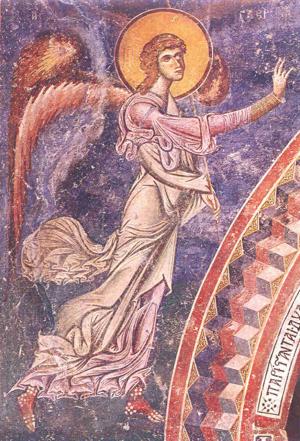 Description:
Description:
On the shore of the lake Prespansko, in the vicinity of the village Kurbinovo, there is a single-nave church with flat ceilings and fresco painting of remarkable content and particularly original style, which has been preserved almost completely so far. The first of our experts who examined the church (the endower of the church is still unknown) were convinced that it dates from Turkish period. Meanwhile, the village around the church has completely disappeared. After more careful analysis the accurate time was established - the end of the 12th century and the late period of the Commenian dynasty in Byzantine Empire. The church of Kurbinovo is the last monument of painting from this epoch, which was characterized by the tendency of extremely expressive style and complex theological content. Here, in the church's altar, a complete scene of the bow (reverence) of archpriests was painted for the first time. Instead of Hetimasija as a symbol of Eucharistic sacrifice of Christ a small lying Christ was painted on the disk - a victim, which will be become a typical iconography of Eastern Church in future. It has a special importance, but a spectator is impressed primarily with aesthetic criteria by which the artist was governed. The physiognomy of the saints is without refined plasticity and sometimes so unattractive that it resembles caricature. Excessively elongated figures with vivid gestures do not necessarily act in accordance with the logic of anatomy. The coloring is powerful and contrasting; swirling draperies are wrapped around cylindrical limbs with thick ornamental folds, which are sometimes separated and present a picturesque detail themselves. The inner line of the forms breaks and waves the figures and makes them only the extensions of whirling movements that illustrate cylindrical, serpent-like, meander-like, and beamlike folds. Although Commenian mannerism is regarded as provincial straying away from the classicism and divine beauty of the frescos in Nerezi, the powerful expression of the painter's brush in the church in Kurbinovo, intensive colors, and achieved visualization witness the search for new aesthetics capable of expressing torments and troublesome feelings of the artists and spectators at the end of the 12th century. This was the time when old Byzantine Empire was dying and vanishing, when the influence of the Western Empire was unrestrainedly penetrating. The ideal of classicism, so persistently and successfully cherished in the East, loses the very reasons for its existence. The Serbian state which begins its affirmation as a young kingdom in the time when the Latins are conquering Constantinople, inherits the classicism and develops it in its most noble form of classical beauty, peace, and spiritual stability that can be seen in the frescos of the monastery Studenica, Milesevo, and Sopocani. Today, the frescos in the church of Kurbinovo, with their "wonderful and creative" ugliness can be a motive for many reflections and questions. Artistic expression of one epoch is always a precise indicator of its conditions. During the time of crisis the ideal of classicism is always fading away and it is replaced expressiveness, powerfulness, roughness, extremity, and frequently a highly emphasized ugliness. One should only consider the art of the 20th century in Europe; it can have a place in a psychiatric textbook par excellence. However, striving for an ideal in ordinary man has conditioned the blooming, among other things, a branch of surgery, which instead of being corrective more and more establishes itself as aesthetic. Recent lectures given by Dr. Panfilov (Germany), one of the leading experts in this field, and which were highly popularized through mass media, treats this problem from the ethical point of view, which is an important improvement. A human being is the kind of person that he is - created by God and nature. This is the foundation from which the art of all epochs accumulates its complete formal expression. When we look at the frescos of the church in Kurbinovo we might as well ask ourselves whether there is any justification or way for the intervention of medicine.
Ljubomir Vujaklija